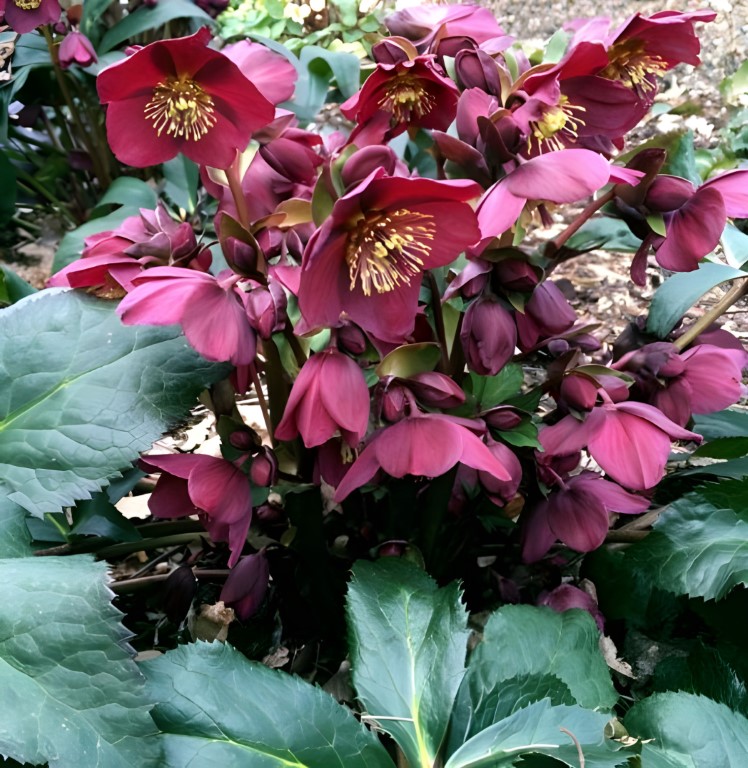by Ken Lain, the Top10Gardener
Introducing a captivating addition to any garden landscape. With its delicate, blooms contrasting against deep green foliage, this resilient perennial brings a touch of elegance to even the coldest winter days. Ice & Roses thrives in challenging conditions, from frosty winters to scorching summers, making it a reliable and low-maintenance choice for both novice and seasoned gardeners alike. Its compact size and bushy habit make it ideal for borders, containers, or as a focal point in mixed beds. Whether adorning a quaint cottage garden or a modern urban landscape, Ice & Roses Lenton Rose is sure to enchant with its enduring beauty and enduring charm, making it a must-have for every garden enthusiast.

Botanical name Helleborus
Common name Lenton Rose
Size at Maturity Fast-growing reaching 18” inches tall x 22” inches wide
Bloom Time Late winter through early spring
Deciduous/ Evergreen Evergreen
Flower Attribute Showy Flowers
Flower Color Red, Pink to pure white
Foliage Color Evergreen
Garden Styles Asian/Zen, Containers, Contemporary, Rustic, Woodland
Growth Habit Compact
USDA Zone 4 to 9, USDA
Landscape Use Border, Containers, Firescaping/Fire Wise, Hedge, Mass Planting, Specimen, Woodland Garden
Light Needs Filtered sun, Partial shade, Partial sun
Special Feature Dramatic Foliage, Year-round Interest, Compact Form
Water Needs Moderate
Key Feature Sensational Flowering Perennial in Late winter
Lenton Rose Hellebore Care
Provide organically rich, moist, well-drained soil; site where it will remain undisturbed for years. Water regularly in first growing season to establish root system; once established, tolerates dry spells in cool, shady settings. Apply acid fertilizer after bloom. Protect roots with a thick layer of mulch. Remove old, faded foliage in spring.
Light Needs
Filtered sun, Partial shade, partial sun
Water Needs
Water regularly – weekly, or more often in extreme heat or containers. This plant prefers consistently moist but not soggy soil. Water whenever the soil begins to dry out due to a lack of rainfall and/or hot weather. Soil that is too dry will impede the plant’s growth and flowering.
Soil
Hellebore prefers organically rich soil with good drainage. But it can grow in a range of soil types, including clay soil. It likes neutral soil pH but can tolerate slightly alkaline soil.
Temperature and Humidity
Hellebore prefers mild conditions with average humidity. Temperatures between 60 and 80 degrees are ideal with cool mountain nights.
Fertilizer
Keep this evergreen perennial happy by feeding 3x times per year with 7-4-4 All Purpose Food (March, July, and October).
Toxins
Wild animals avoid the hellebore, especially deer, antelope and rabbits. Hellebore is moderatly toxic if eaten in significant proportions.
Fortunately, suppose you need to work with the hellebore in your garden. In that case, you don’t have to worry about experiencing symptoms via skin contact from handling the plant.
Better Together: Companion Plants for February
Your grandmother would fall in love with these larger varieties with so many colors to choose from. There’s nothing like the enormous flowers to add vibrant stunning pops of color. Endearing springtime blooms are more than fragrant with luscious double flowers. Perfect for cut flowers in a spring bouquet. These hard mountain varieties take the brutal sun, wind for decades of perennial enjoyment. Deer are Javelina will ignore these peony beauties.
Lily of the Valley – This gorgeousshrub loves growing in the summer shade of a Pinyon Pine. This bold winter evergreen delights with dramatic firey growth in spring, producing clusters of fragrant flowers. Exquisite wedding cake layers of white flowers hover on graceful, arching stems most of winter and spring. The easy-care rounded form stands out with shiny foliage all winter, opening to white bell-shaped blooms in spring. This knee-high shrub is utterly detestable to all deer and Javelina.
Rich green mounds of juniper beauty only grow ankle-high for the perfect mountain ground cover. An ideal choice for low water, low care erosion control on natural banks where monsoon run-off is a problem. The perfect green nestled between boulders or soften the top edge of a masonry retaining wall. Ideally used to add color and style next to a barren rock lawn through the winter months. Junipers are always naturally welcome in Japanese gardens or pruned into creative bonsai forms.
Pinyon Pine – Thick, evergreen needles provide year-round beauty with summer shade to dry mountain landscapes but blend in equally well a modern or Mediterranean garden style.

